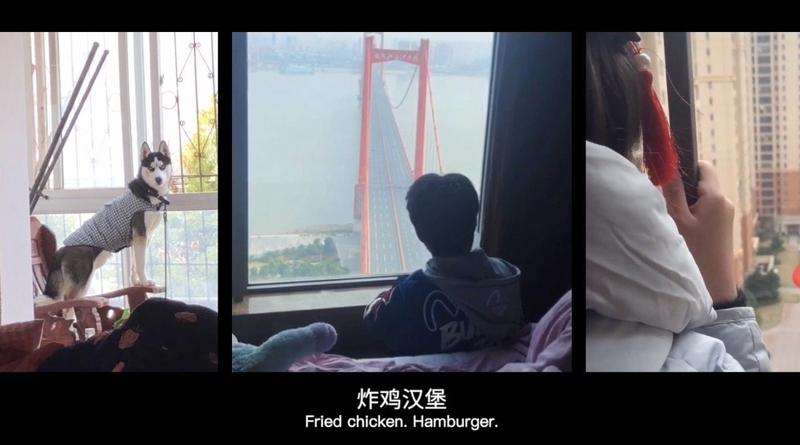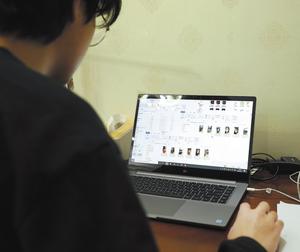A documentary produced by college students shows Wuhan's fight against COVID-19 from the perspective of its people through moving videos they posted online, Li Yingxue reports.
 In the documentary Wuhan 2020: How We Fight COVID-19, a split-screen format is applied to show different scenes filmed at the same time during the lockdown. Not surprisingly, food is uppermost in people's minds. (PHOTO PROVIDED TO CHINA DAILY)
In the documentary Wuhan 2020: How We Fight COVID-19, a split-screen format is applied to show different scenes filmed at the same time during the lockdown. Not surprisingly, food is uppermost in people's minds. (PHOTO PROVIDED TO CHINA DAILY)
Most documentaries are filmed by seasoned professional cameramen or women. This one, however, is comprised of 112 short videos filmed in Wuhan by 77 members of the general public, and put together by a dozen university students charged with collecting and editing them.
Titled Wuhan 2020: How We Fight COVID-19, the documentary was released on Chinese micro-blogging platform Sina Weibo on April 2, and reviews the lives of local people-their joy, tears, humor and fear-in Wuhan from Jan 1 to Feb 8, the period between New Year's Day and the Chinese Lantern Festival.
Within the first five days of its release, it garnered more than 30 million views. The documentary is made by Tsingying Film and video-sharing social network Kuaishou.
Tsingying Film was set up in 2006 by students, alumni and faculty members of Tsinghua University's School of Journalism and Communication. Previous documentaries include Himalaya: Ladder to Paradise and Masters in Forbidden City.
According to Sun Hong, co-director of the documentary, a dozen members joined the project voluntarily and the 18-minute documentary took the team around six weeks to finish.
They scoured tens of thousands of videos on Kuaishou and, with the authorization of the content owners, selected 112 clips from 77 users to make the documentary.
Sun, 33, a doctoral student in journalism and communication at the university, says that, even though they could not visit Wuhan to shoot a documentary with firsthand material from the front line, they saw what was happening in that city through the hundreds of video clips recorded by Wuhan locals on their cellphones.
"We wanted to collect the tons of information and pin down the most touching moments, showing Wuhan during this Spring Festival from a more human angle, presented by the city's thousands of residents," Sun says.
 Sun Hong, one of the documentary's directors, reviews filming. (PHOTO PROVIDED TO CHINA DAILY)
Sun Hong, one of the documentary's directors, reviews filming. (PHOTO PROVIDED TO CHINA DAILY)
Sun says that many documentaries about Wuhan during the pandemic followed stories on individuals, while their work tries to present images of a group of people.
"When the city was under lockdown, some people may have recorded the empty street which, for them, may convey a feeling of loneliness and panic, while some others may have been happy to be at home with their family… All these feelings build a live and real picture of Wuhan for us," Sun explains.
"All of the moments recorded on smartphones tell us that, when facing the pandemic, no city is alone."
Many elements in the film touched Sun. For example, on the night of Jan 27, people in one local community all opened their windows and cheered for the city and its people loudly, singing together-that moment is one of the many that reduced Sun to tears, as she believes that the singing seemed to have the magic power to connect each single person together in the fight against the pandemic.
Sun also saw the optimistic spirit in the people of Wuhan from their daily lives, exemplified by one clip of a woman who grows vegetables on her balcony and harvests them to cook later.
Sun says the documentary is also a commemoration of doctor Li Wenliang, one of the eight people who first raised concerns about the novel coronavirus when initial cases emerged in Wuhan. He died from the virus in early February.
The production team was divided into three groups. One searched for, and filtered the footage, another edited the selected short films, and the third was charged with the role of producers, performing tasks, such as communicating with the owners of the selected content to get permission to use their clips.
 A poster of the documentary portrays various aspects of life in Wuhan. (PHOTO PROVIDED TO CHINA DAILY)
A poster of the documentary portrays various aspects of life in Wuhan. (PHOTO PROVIDED TO CHINA DAILY)
A search for emotion
Tan Chongqing, a junior journalism student at Tsinghua University, was among the eight-person team tasked with finding the footage.
Tan, however, had an advantage over his colleagues-he is a Wuhan local.
In mid-January, when the winter vacation started, Tan went back home to the city. He has spent nearly three months with his parents and his sister. When he heard about the documentary, he signed up immediately.
"I haven't watched short videos on Kuaishou before, but I could use my local advantage to search for the videos of people nearby," Tan says.
There are tens of thousands of videos on Kuaishou, so Tan also used the names of local snacks and roads as keywords in his searches.
Between Feb 9 and 15, every day Tan and his teammates would each submit 30 clips they had chosen to the database of the documentary.
"We have two rules when selecting the materials-one is that it has to be documentary footage with no background music and filmed by the user, and the other is that it has to touch the viewers in some way," he says.
One clip that particularly moved him during his search was of a volunteer driver from Shaanxi province, who transferred goods to support Wuhan. "His case showed that every single person was helping Wuhan in their own way," Tan says.
Footage gathered by Tan and his team also included people's lives under quarantine and the daily routines of those under lockdown at home.
"We were able to find some footage of doctors and nurses who came to support Wuhan, but only before they were engaged in their work. Once they stepped into the hospitals, they no longer had the time to take selfies and record videos," he adds.
 Tan Chongqing, a junior journalism student at Tsinghua University, is one of the team in charge of finding footage filmed by Wuhan residents. (PHOTO PROVIDED TO CHINA DAILY)
Tan Chongqing, a junior journalism student at Tsinghua University, is one of the team in charge of finding footage filmed by Wuhan residents. (PHOTO PROVIDED TO CHINA DAILY)
For each user who uploaded a video Tan found interesting, he would follow that user's updates and browse through all of the videos they had posted.
"Before the pandemic, they may have made funny videos, but since the lockdown began, they all started recording their daily lives," Tan points out.
He says he noticed that on Sina Weibo people tend to talk about the pandemic all day long, but it's more about expressing emotion, while on the short video-sharing platforms, it's more about recording the reality.
"The videos made by users are more relaxed and real. They talk to the camera directly, and they may present more angles to what life is like in Wuhan, even though it's not that continuous as a story," Tan says.
"Our documentary may be different to ones made by news agencies, but it's a record of Wuhan's people."
One highlight of the film is when it uses a split screen to show things that happened in Wuhan in different places at the same time.
Liang Junjian, a documentary director and associate professor at Tsinghua University, agrees that the documentary is different to more conventional productions.
"It's mainly narrations from different people, and it's a collection and recreation of this type of narration," Liang says.
He thinks that on one hand, employing user-generated content provides a wider picture, but, on the other hand, it can lack depth.
The documentary has received 7.4 points out of a total 10 on review site Douban. One comment says "there is no attempt at sensation or filtering, only the reality depicted in the film".
Wang Jing, producer of the documentary, says she believes that the project is a good opportunity for journalism students at the university to practice their skills.
"Usually a student would need assignments to start working, but this time we have a thought of the project first, then we scheduled the resources to fulfill it," she explains.
Contact the writer at liyingxue@chinadaily.com.cn


